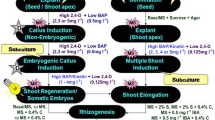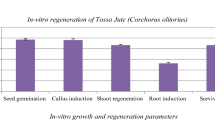Abstract
Trifolium alexandrinum L. (Egyptian clover) is one of the most important forage crops in the world. Its regeneration in tissue culture has been described in a few reports but the efficiency, accurate time scales and applicability to various genotypes of the described procedures are uncertain. Therefore their suitability for genetic transformation is unclear. In this study, were report new fast procedures for regeneration of Egyptian clover that are applicable to the regeneration of various genotypes (Mescawi-ahaly, Sakha3 and Sakha4). Shoots were regenerated from intact and wounded cotyledons as well as hypocotyls of Mescawi-ahaly on naphthaleneacetic acid/benzyladenine (NAA/BA) and naphthaleneacetic acid/thidiazuron (NAA/TDZ) media. The highest shoot regeneration frequencies were obtained from intact cotyledons on NAA/BA (0.05 mg l−1 NAA combined with 2.0 mg l−1 BA) and NAA/TDZ (0.05 mg l−1 NAA combined with 1.0 mg l−1 TDZ) media (66.2 and 43.1% respectively) compared to 18.4 and 10.1% for wounded cotyledons on NAA/BA and NAA/TDZ respectively. 21.0% shoot regeneration frequency was observed for hypocotyls on NAA/BA (2.0 mg l−1 NAA combined with 0.5 mg l−1 BA) medium but no regeneration was obtained on NAA/TDZ medium. Rooting of the regenerated shoots was induced on indole butyric acid (IBA: 0.24 mg l−1) or NAA (2.0 mg l−1) media where IBA medium supported significantly higher frequencies of rooting as well as survival of the whole plantlets after transfer to soil. However, the rooting and survival frequencies also depended on the type of explant and the medium used for shoot regeneration. The two cultivars Sakha3 and Sakha4 were regenerated using the culture conditions optimized for Mescawi-ahaly with comparable efficiencies, indicating that the described procedure is not genotype dependent. The time scale of whole plantlet regeneration ranged from 7.5 weeks for intact and wounded cotyledons to 10 weeks for hypocotyl explants.






Similar content being viewed by others
References
Badr A, El-Shazly HH, Watson E (2008) Origin and ancestry of Egyptian clover (Trifolium alexandrinum L.) as revealed by AFLP marker. Genet Resour Crop Evol 55:21–31
Barakat MN (1990) In vitro culture of tissues, cells and protoplasts of Trifolium alexandrinum L. (Egyptian clover). Euphytica 48:103–110
Basalma D, Uranbey S, Mirici S, Kolsarici O (2008) TDZ × IBA induced shoot regeneration from cotyledonary leaves and in vitro multiplication in safflower (Carthamus tinctorius L.). African J Biotech 7:960–966
Beattie LD, Garrett RG (1995) Adventitious shoot production from immature embryos of white clover. Plant Cell Tiss Organ Cult 42:67–72
Ding Y-L, Aldao-Humble G, Ludlow E, Drayton M, Lin Y-H, Nagel J, Dupal M, Zhao G, Pallaghy C, Kalla R, Emmerling M, Spangenberg G (2003) Efficient plant regeneration and Agrobacterium-mediated transformation in Medicago and Trifolium species. Plant Sci 165:1419–1427
George EF, Debergh PC (2008) Micropropagation: uses and methods. In: George EF, Hall MA, De-Klerk G-J (eds) Plant propagation by tissue culture, 3 edn, pp 35–36
Jha TB, Ghosha B (2005) Plant tissue culture: basic and applied. Orient Blackswan
Kane ME (1990) Propagation techniques. In: Trigaino RN, Gray DJ (eds) Plant tissue culture concepts and laboratory exercises (2 edn), pp 80–81
Khan MRI, Heath LC, Spencer D, Higgins TJV (1994) Agrobacterium-mediated transformation of subterranean clover (Trifolium subterraneum L.). Plant Physiol 105:81–88
Knight WE (1985) Miscellaneous annual clovers. In: Taylor NL (ed) Clovers science and technology. Agron Monog 25:547–561
Larkin PJ, Gibson JM, Mathesius U, Weinman JJ, Gartner E, Hall E, Tanner GJ, Rolfe BG, Djordjevic MA (1996) Transgenic white clover studies with the auxin-responsive promoter, Gh3, in root gravitropism and lateral root development. Transgenic Res 5:325–335
Ledbetter DI, Breece JE (2004) Thidiazuron stimulates adventitious shoot production from Hydrangea quercifolia Bartr. leaf explants. Scient Hort 101:121–126
Lu C-Y (1993) The use of thidiazuron in tissue culture. In Vitro Cell Dev Biol 29:92–96
Malik KA, Saxena PK (1992) Regeneration in Phaseolus vulgaris L.: high frequency induction of direct shoot formation in intact seedlings by N 6-benzylaminopurine and thidiazuron. Planta 186:384–389
Mokhtarzadeh A, Constantin MJ (1978) Plant regeneration from hypocotyl- and anther-derived callus of berseem clover. Crop Sci 18:567–572
Murashige T, Skoog F (1962) A revised medium for rapid growth and bioassays with tobacco tissue cultures. Physiol Plant 15:473–497
Quesenberry KH, Wofford DS, Smith RL, Krottje PA, Tcacenco F (1996) Production of red clover transgenic for neomycin phosphotransferase II using Agrobacterium. Crop Sci 36:1045–1048
Roy AK, Malaviya DR, Kaushal P (2005) Pollination behaviour among different breeding populations of Egyptian clover. Plant Breed 124:171–175
Tabrett AM, Hammatt N (1992) Regeneration of shoots from embryo hypocotyls of common ash (Fraxinus excelsior). Plant Cell Rep 11:514–518
Tanaka N, Fujikawa Y, Aly MAM, Saneoka H, Fujita K, Yamashita I (2001) Proliferation and rol gene expression in hairy root lines of Egyptian clover. Plant Cell Tiss Organ Cult 66:175–182
Voisey CR, White DWR, Dudas B, Appleby RD, Ealing PM, Scott AG (1994) Agrobacterium-mediated transformation of white clover using direct shoot organogenesis. Plant Cell Rep 13:309–314
White DWR, Voisey C (1994) Prolific direct plant regeneration from cotyledons of white clover. Plant Cell Rep 13:303–308
Author information
Authors and Affiliations
Corresponding author
Rights and permissions
About this article
Cite this article
Abogadallah, G.M., Quick, W.P. Fast versatile regeneration of Trifolium alexandrinum L.. Plant Cell Tiss Organ Cult 100, 39–48 (2010). https://doi.org/10.1007/s11240-009-9614-y
Received:
Accepted:
Published:
Issue Date:
DOI: https://doi.org/10.1007/s11240-009-9614-y




